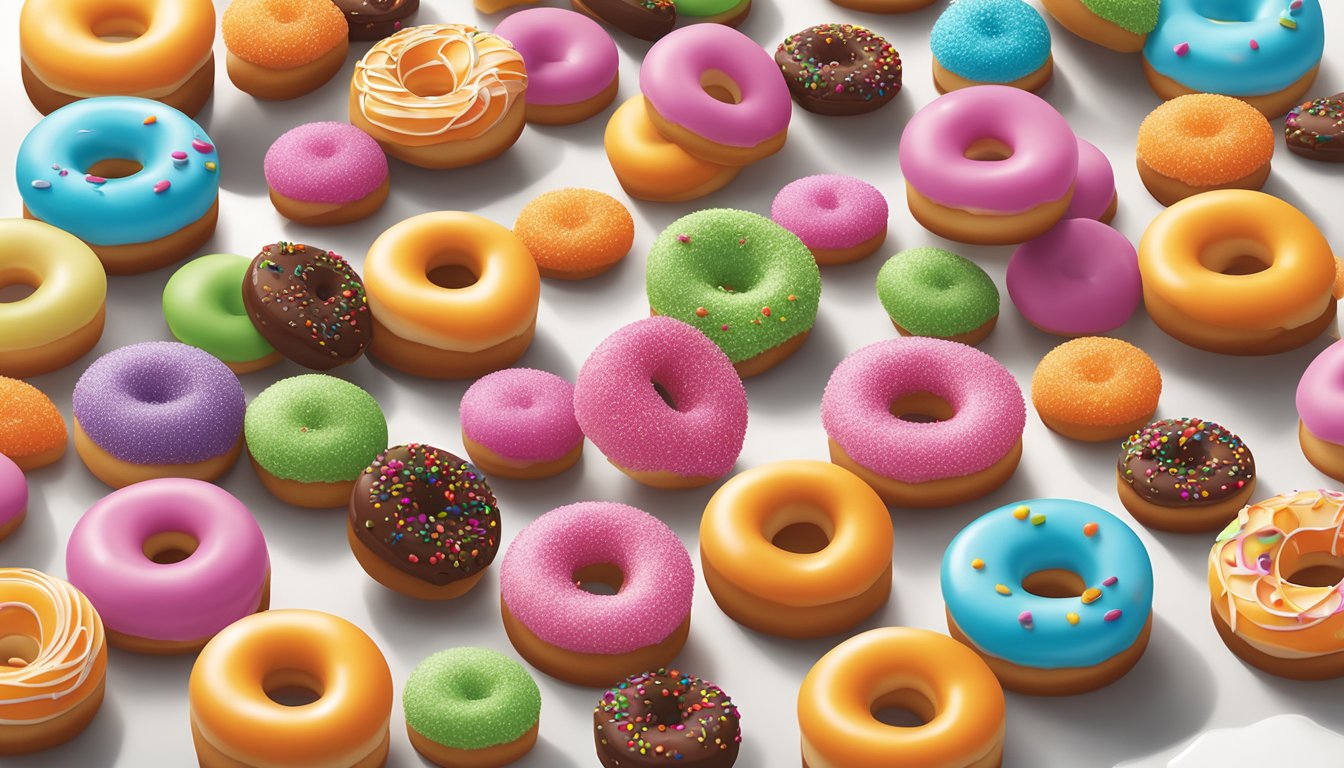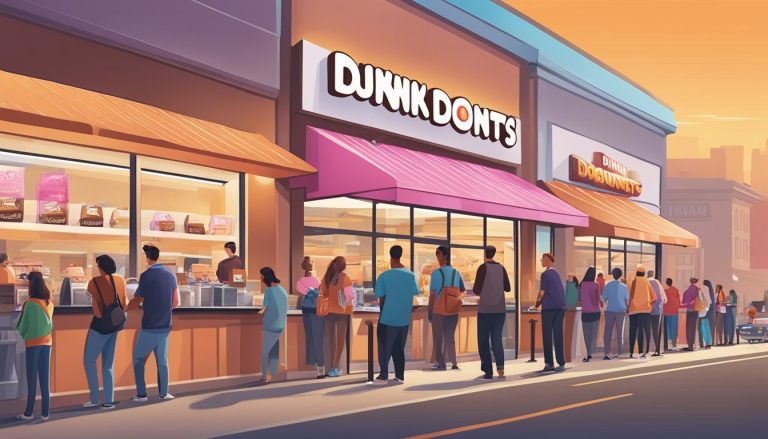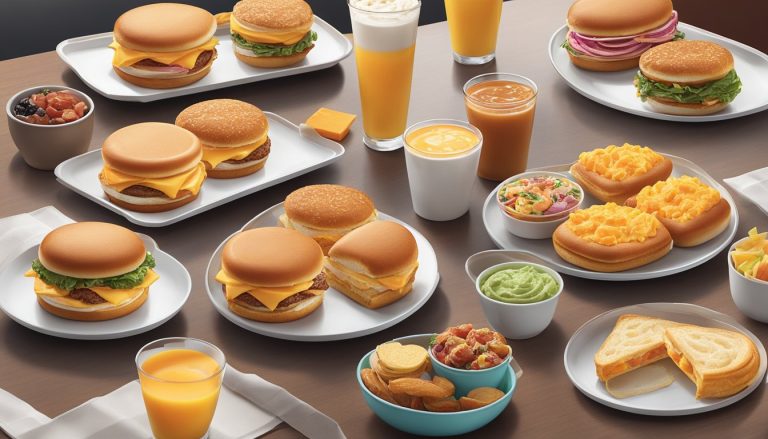Dunkin’s Munchkins have become an iconic treat since their introduction in 1972. These bite-sized donut holes were born out of resourcefulness, as Dunkin’ sought to repurpose the excess dough from cutting out the centers of regular donuts. What started as a simple solution to reduce waste has grown into a beloved snack, with Dunkin’ now selling approximately 800 million Munchkins annually.
The popularity of Munchkins has led to an expansion of flavors over the years. Today, customers can choose from more than ten varieties in the United States, including classic options like glazed, jelly-filled, and powdered sugar. Munchkins are available in various quantities, from small packs of 3 or 5 to larger boxes of 25 or 50, making them a versatile treat for individual snacking or sharing with friends and colleagues.
Munchkins have become a staple offering at Dunkin’, complementing the chain’s coffee and other baked goods. Their compact size and diverse flavors have contributed to their enduring appeal, allowing customers to enjoy a taste of Dunkin’s donuts in a convenient, bite-sized format. The success of Munchkins demonstrates how a simple idea can evolve into a significant part of a company’s identity and product line.
The Origins of Dunkin’ and Munchkins
Dunkin’ and its iconic Munchkins have a rich history dating back to the mid-20th century. The company’s journey from a small local shop to a global brand is marked by innovation and adaptability.
William Rosenberg’s Vision
William Rosenberg, an entrepreneurial spirit, founded the precursor to Dunkin’ in 1946. He noticed workers at construction sites and factories lacked quality food options during their breaks. Rosenberg saw an opportunity to provide fresh, delicious food to these hardworking individuals.
His initial venture, Industrial Luncheon Services, used converted telephone company trucks to sell sandwiches, coffee, and donuts at factories and construction sites. The success of this mobile catering business led Rosenberg to realize the potential of focusing on coffee and donuts.
The Launch of Open Kettle
In 1948, Rosenberg opened his first brick-and-mortar establishment in Quincy, Massachusetts. He named it “Open Kettle,” reflecting the open-kitchen concept where customers could watch their donuts being made fresh.
The menu featured coffee for 10 cents and donuts for 5 cents. Open Kettle quickly gained popularity among locals for its fresh, high-quality offerings. Rosenberg’s commitment to serving excellent products at affordable prices laid the foundation for the brand’s future success.
Rebranding to Dunkin’ Donuts
After two years of operation, Rosenberg decided to rebrand his successful shop. In 1950, Open Kettle became “Dunkin’ Donuts.” The new name emphasized the core products and the unique way customers could enjoy them.
Rosenberg’s vision extended beyond a single shop. He began franchising Dunkin’ Donuts in 1955, allowing the brand to expand rapidly. By 1963, the 100th location opened, marking the beginning of Dunkin’ Donuts’ journey to becoming a household name.
Inception of the Munchkin
In 1972, Dunkin’ Donuts introduced Munchkins, its iconic donut hole treats. The creation of Munchkins was a stroke of resourcefulness and ingenuity. Initially, the centers cut out from regular donuts were discarded.
Dunkin’ management saw an opportunity to repurpose this excess dough into a new product. The name “Munchkins” was inspired by the small characters from “The Wizard of Oz.”
A special tool was developed to ensure uniform cutting of Munchkins from regular donuts. This innovation allowed for consistent quality and efficient production. Munchkins quickly became a fan favorite, offering a bite-sized version of Dunkin’s popular donuts.
Expanding the Munchkin Line
Dunkin’ has continually innovated its Munchkin offerings since their introduction. The company expanded flavors, created new varieties, and introduced seasonal options to keep customers excited about these bite-sized treats.
Introduction of New Flavors
Dunkin’ expanded beyond the original glazed Munchkins to offer a diverse range of flavors. Popular additions included chocolate, jelly-filled, and powdered sugar varieties. Blueberry and butternut became fan favorites.
The company also introduced cake-based Munchkins alongside the traditional yeast-style. This allowed for unique flavors like red velvet and birthday cake.
Dunkin’ regularly rotates flavors to keep the selection fresh and exciting. Some locations offer over ten different Munchkin varieties daily.
Munchkin Innovation
Dunkin’ developed specialized equipment to create perfectly uniform Munchkins. This ensured consistent quality and appearance across all locations.
The company experimented with filled Munchkins, injecting them with flavored creams and jellies. This innovation expanded texture and flavor possibilities.
Dunkin’ also introduced Munchkins Combo Packs, allowing customers to mix and match their favorite flavors in convenient boxes.
Health-conscious options emerged, including reduced-fat and whole-grain Munchkins. These catered to changing consumer preferences.
Seasonal and Limited-Edition Varieties
Dunkin’ capitalized on holiday themes with seasonal Munchkin flavors. Popular options included:
- Pumpkin spice (fall)
- Gingerbread (winter)
- Peeps-flavored (spring)
The company launched limited-time flavors to generate excitement. These exclusive varieties often tied into marketing campaigns or pop culture events.
Dunkin’ collaborated with other brands to create unique Munchkin flavors. These partnerships resulted in unexpected and buzz-worthy combinations.
Special edition Munchkins sometimes featured colorful coatings or sprinkles to match holidays or celebrations. This visual appeal made them popular for parties and gatherings.
Marketing the Munchkin
Dunkin’ employed diverse strategies to promote its beloved Munchkins. The company’s marketing efforts focused on brand awareness, customer loyalty, and leveraging its iconic slogan.
Targeted Advertising Strategies
Dunkin’ utilized multi-channel advertising to reach its target audience. Television commercials showcased the bite-sized treats, emphasizing their convenience and variety. Print ads in magazines and newspapers featured mouthwatering images of Munchkins.
Digital marketing campaigns on social media platforms engaged younger consumers. The company created hashtags and encouraged user-generated content, sparking viral trends.
Dunkin’ also partnered with influencers to promote Munchkins on Instagram and TikTok. These collaborations increased brand visibility and appealed to millennial and Gen Z demographics.
Loyalty Programs and Promotions
The DD Perks rewards program incentivized frequent Munchkin purchases. Members earned points for every dollar spent, redeemable for free food and beverages.
Dunkin’ introduced limited-time flavors and seasonal promotions to drive sales. Holiday-themed Munchkin boxes became popular gift options.
Special offers, such as “Buy One, Get One Free” deals, encouraged customers to try new flavors. The company also bundled Munchkins with coffee purchases to boost overall sales.
The Role of ‘America Runs on Dunkin’
The iconic slogan “America Runs on Dunkin'” played a crucial role in marketing Munchkins. This catchphrase reinforced the brand’s position as a daily staple for millions of Americans.
Dunkin’ incorporated Munchkins into its broader marketing campaigns, showcasing them alongside coffee and other menu items. This strategy positioned Munchkins as an essential part of the Dunkin’ experience.
The slogan’s emphasis on convenience and reliability aligned perfectly with Munchkins’ grab-and-go nature. This synergy strengthened the product’s appeal to busy consumers seeking quick, satisfying snacks.
Cultural Impact of Dunkin’s Munchkins
Munchkins have become a beloved treat deeply woven into American food culture. These bite-sized doughnut holes have shaped breakfast habits, symbolized small indulgences, and influenced snack food trends across the country.
Part of American Breakfast Culture
Munchkins have carved out a unique place in American breakfast routines. Many Dunkin’ locations sell these portable treats alongside coffee, creating a popular grab-and-go option for busy mornings. Offices and schools often feature boxes of Munchkins for shared breakfasts or celebrations.
The variety of flavors appeals to different tastes, from classic glazed to seasonal specialties. This versatility has helped Munchkins become a staple at morning meetings and weekend brunches alike. Their shareable nature encourages social eating experiences, fostering a sense of community around food.
Symbolic as a Sweet Treat
Munchkins have come to symbolize small indulgences in American culture. Their bite-sized nature allows people to enjoy a sweet treat without the guilt associated with full-sized doughnuts. This positioning has made Munchkins a popular choice for those seeking moderation in their snacking habits.
The term “Munchkin” itself has entered common language, often used to describe anything small and cute. This linguistic impact extends beyond food, reflecting the product’s cultural significance. Munchkins are frequently given as rewards or comfort food, reinforcing their role as a simple pleasure in daily life.
Influence on Snack Food Industry
Dunkin’s success with Munchkins has inspired other companies to create similar bite-sized snacks. This trend has expanded beyond doughnuts to include miniature versions of cookies, cakes, and other baked goods. The popularity of these small treats has led to increased demand for portion-controlled snack options.
Munchkins have also influenced packaging and marketing strategies in the snack food industry. The iconic box design has become recognizable, and other brands have adopted similar packaging for their miniature treats. This shift towards smaller, shareable portions has reshaped how consumers approach snacking and portion sizes.
Product and Service Evolution

Dunkin’ transformed from a simple donut shop to a global quick-service restaurant chain. The company expanded its menu, adapted to changing consumer preferences, and grew its franchise network.
Expanding Beyond Donuts
Dunkin’ introduced bagels in 1996, marking its first major expansion beyond donuts. This move appealed to health-conscious customers seeking alternatives to sweet treats. In 1997, the company launched breakfast sandwiches, catering to the growing demand for convenient morning meals. The menu continued to evolve with the addition of hash browns, wraps, and specialty coffee drinks.
Dunkin’ also embraced customization options. Customers could now choose from various bagel flavors, sandwich fillings, and coffee add-ins. This flexibility allowed Dunkin’ to compete with other fast-food chains and coffee shops.
Adaptation to Consumer Trends
Dunkin’ responded to health and dietary trends by introducing lighter options. The company added fruit smoothies, oatmeal, and egg white sandwiches to its menu. In 2014, Dunkin’ launched its DDSMART menu, featuring items under 400 calories.
The brand also embraced digital technology. Dunkin’ introduced mobile ordering and payment through its app in 2016. This innovation improved customer convenience and reduced wait times. The company later implemented digital kiosks in some locations for faster service.
Franchise Growth and Development
Dunkin’ expanded rapidly through franchising. The company provided comprehensive training and support to franchise owners. This approach ensured consistent quality across locations while allowing for local market adaptations.
By 2019, Dunkin’ had over 12,900 locations worldwide. The brand focused on strategic expansion, targeting high-traffic areas and transport hubs. Dunkin’ also introduced smaller-format stores to enter new markets efficiently.
Franchise owners benefited from Dunkin’s marketing initiatives and product innovations. The company’s strong brand recognition and loyal customer base contributed to the success of new franchise locations.
Dunkin’s Munchkins in the Beverage Line
Dunkin’ has integrated its beloved Munchkins into creative beverage offerings. These bite-sized treats complement coffee drinks and add a playful twist to iced coffee combinations.
Pairing with Coffee
Dunkin’ offers Munchkins as a perfect accompaniment to its coffee beverages. Customers can enjoy a box of assorted Munchkins alongside their hot coffee for a satisfying breakfast or snack. Popular pairings include chocolate glazed Munchkins with a medium roast coffee or jelly-filled Munchkins with a latte.
Some Dunkin’ locations feature promotions that bundle coffee and Munchkins together at a discounted price. This pairing encourages customers to try different flavor combinations and enhances the overall coffee experience.
Dunkin’ has also introduced seasonal Munchkin flavors that complement limited-time coffee offerings. For example, pumpkin Munchkins pair well with pumpkin spice lattes during fall months.
Iced Coffee Combinations
Dunkin’ has incorporated Munchkins into its iced coffee menu in innovative ways. The chain offers “Munchkin Madness” iced coffee, which blends crushed Munchkins into the drink for added texture and flavor.
Popular combinations include vanilla iced coffee with glazed Munchkin pieces and mocha iced coffee with chocolate Munchkin crumbles. These beverages provide a unique twist on traditional iced coffee, appealing to customers seeking indulgent treats.
Dunkin’ has also experimented with Munchkin-inspired iced coffee flavors. For instance, the “Jelly Donut Iced Coffee” captures the essence of jelly-filled Munchkins in a refreshing beverage format.
Some locations offer customizable iced coffee options where customers can choose their favorite Munchkin flavors to be blended into their drinks.




